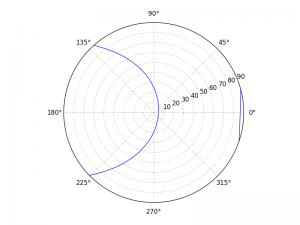 As part my PhD, I used GPS satellites to measure the beam pattern of a telescope I built. While this can be done easily with the pyEphem module, I found that there wasn’t much documentation out there on the interwebs. So, I’ve written a simple Python script (below) which takes you through the basics of using pyEphem to track the path of GPS satellites.
As part my PhD, I used GPS satellites to measure the beam pattern of a telescope I built. While this can be done easily with the pyEphem module, I found that there wasn’t much documentation out there on the interwebs. So, I’ve written a simple Python script (below) which takes you through the basics of using pyEphem to track the path of GPS satellites.
Firstly, you’ll be needing a list of GPS satellites. This can be downloaded from:
http://www.celestrak.com/NORAD/elements/
This is in the form of Two-Line Element sets (TLEs — which humorously are three lines long). You can load these into pyEphem using the readtle() command.
Anyway, here’s the script. You’ll need numpy, matplotlib and of course the pyEphem module:
import numpy as np import pylab as plt import ephem import datetime
# Setup lat long of telescope
oxford = ephem.Observer()
oxford.lat = np.deg2rad(51.75)
oxford.long = np.deg2rad(-1.259)
oxford.date = datetime.now()
# Load Satellite TLE data. l1 = 'GPS-BIIF-1' l2 = '1 36585U 10022A 12102.71732698 -.00000026 00000-0 10000-3 0 7813' l3 = '2 36585 55.4685 55.7745 0013418 26.7546 333.2981 2.00556192 13724' biif1 = ephem.readtle(l1,l2,l3) # Make some datetimes midnight = datetime.datetime.replace(datetime.datetime.now(), hour=0) dt = [midnight + datetime.timedelta(minutes=20*x) for x in range(0, 24*3)] # Compute satellite locations at each datetime sat_alt, sat_az = [], [] for date in dt: oxford.date = date biif1.compute(oxford) sat_alt.append(np.rad2deg(biif1.alt)) sat_az.append(np.rad2deg(biif1.az))
# Plot satellite tracks plt.subplot(211) plt.plot(dt, sat_alt) plt.ylabel("Altitude (deg)") plt.xticks(rotation=25) plt.subplot(212) plt.plot(dt, sat_az) plt.ylabel("Azimuth (deg)") plt.xticks(rotation=25) plt.show() # Plot satellite track in polar coordinates plt.polar(np.deg2rad(sat_az), 90-np.array(sat_alt)) plt.ylim(0,90) plt.show()
This script creates a pyEphem observer and a satellite object, computes the altitude and azimuth of the satellite as seen from the observer, and then plots the results. If you find the datetime.datetime stuff confusing, I highly recommend Salty Crane’s cheat sheet.
After the script has run, you should see this polar plot of the satellite’s trajectory:
Finally, here’s a simple function to read in a text file filled with TLE data:
def loadTLE(filename):
""" Loads a TLE file and creates a list of satellites."""
f = open(filename)
satlist = []
l1 = f.readline()
while l1:
l2 = f.readline()
l3 = f.readline()
sat = ephem.readtle(l1,l2,l3)
satlist.append(sat)
print sat.name
l1 = f.readline()
f.close()
print "%i satellites loaded into list"%len(satlist)
return satlist
Hope this comes in helpful for someone!
